Faculty DirectoryMagdalena Osburn

Associate Professor of Earth and Planetary Sciences and (by courtesy) Civil and Environmental Engineering
Contact
2145 Sheridan RoadTech F291 / F292
Evanston, IL 60208-3109
847-491-4254Email Magdalena Osburn
Website
Departments
Civil and Environmental Engineering
Education
Ph.D. Geobiology, California Institute of Technology, Division of Geological and Planetary ScienceM.S. Geobiology, California Institute of Technology, Division of Geological and Planetary Science
B.A. summa cum laude, Earth & Planetary Sciences, Environmental Studies, Washington University in St. Louis
Research Interests
Biological molecules record information about both their formation environment and the organisms that produce them. I use a class of molecules called lipids to study the habits of modern and ancient microbes. Lipids are found in the membranes of all organisms and their structures can be highly diagnostic of particular biological groups. Lipids are made primarily of C and H (also N, P, O, and S). As these atoms are incorporated into the lipid structure they preserve isotopic signals of both biological and environmental processes. The major advantage of lipids for geoscientists is that they can be preserved on very long timescales, and thus can archive information about past environments in sediments and rocks. My research applies tools from organic geochemistry, microbiology, and stratigraphy to investigate microbial and biogeochemical cycling in both modern and ancient environments.
A major ongoing portion of my research focuses on understanding what type of information is record by the hydrogen isotopic composition of lipids. We know that D/H reflects environmental water, but it can also vary with humidity, salinity, and, most importantly for my research, microbial metabolism. This work includes both in lab culturing experiments to expand the data base of isolate D/H, and field studies aimed at understanding the nuances of this technique in particular environments.
Other current and past research topics include:
- Geochemical modeling of aqueous environments to understand the energetic potential and limits of microbial life (Currently focused on the deep subsurface environment)
- Neoproterozoic chemical evolution of the ocean-atmosphere system during extreme isotope excursions (mostly in Oman thus far, Chemostratigraphy, modeling, field work)
- Carbonate sedimentology, stratigraphy, and geochemistry with an emphasis on microbialite preservation and morphology.
Courses Taught
- EARTH 331 - Field Problems in Sedimentary Geology
- EARTH 370 - Geobiology
Selected Publications
Osburn, Magdalena, Grotzinger, J., Bergmann, KB, 2013. Stratigraphic characterization of an Ediacaran aged carbonate ramp: Khufai Formation, Sultanate of Oman. AAPG Bulletin, available online 2013.
Meyer-Dombard, Amend, J.P., Osburn, Magdalena R., 2013. Microbial diversity and potential for arsenic and iron biogeochemical cycling at an arsenic rich, shallow-sea hydrothermal vent (Tutum Bay, Papua New Guinea). Chemical Geology 348, 37.
Osburn, Magdalena R., Alex L. Sessions, Charles Pepe-Ranney, John R. Spear, 2011. Hydrogen-isotopic variability in fatty acids from Yellowstone National Park hot spring microbial communities. Geochimica Cosmochimica Acta 75, 4830.
Osburn, Magdalena R., Amend, J.P., 2011. Thermogladius shockii gen. nov., sp. nov., a hyperthermophilic crenarchaeote from Yellowstone National Park, USA. Archives of Microbiology 193, 45.